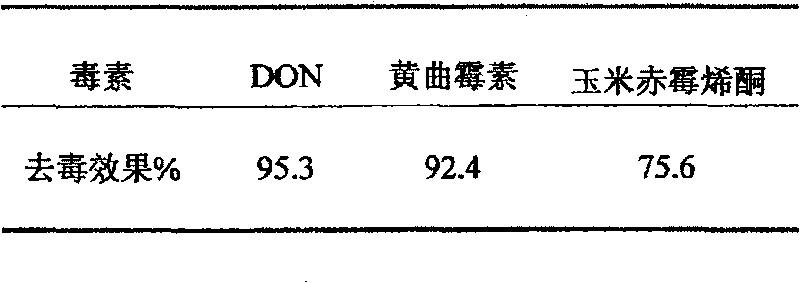Bacterial strain capable of degrading mold toxin and formulation preparation method thereof
A technology for mycotoxins and preparations, which is applied in the field of preparation of strains capable of degrading mycotoxins and preparations thereof, can solve problems such as mycotoxins contamination, and achieve the effects of ensuring food safety, low production and use costs, and obvious detoxification effects.
- Summary
- Abstract
- Description
- Claims
- Application Information
AI Technical Summary
Problems solved by technology
Method used
Image
Examples
Embodiment 1
[0023] Acquisition of A16
[0024] Soil samples were collected from the wheat field of Jiangsu Academy of Agricultural Sciences, and deoxynivalenol was used for multiple subculture enrichment cultures in the laboratory (30°C, once a week), and deoxynivalenol could be degraded. Bacterial suspension of enol, spread the bacterial suspension on LB medium (30°C, 7d), pick different colonies on the plate, and verify the degradation effect of deoxynivalenol one by one Finally, a strain capable of degrading deoxynivalenol was obtained, added glycerol, and stored in a -70°C refrigerator. For this strain, it is defined as A16.
[0025] By measuring the physiological and biochemical characteristics of A16, cloning the 16SrDNA sequence of A16 and sequencing the 16SrDNA sequence, and comparing the sequencing results with BLAST in Genbank, the phylogenetic evolutionary status of A16 was determined. Through the results of the physiological and biochemical characteristics of A16 and the res...
Embodiment 2
[0028] Preparation of liquid inoculum
[0029] Medium: Glucose 1.0%, (NH 4 ) 2 SO 4 0.1%, K 2 HPO 4 0.2%, MgSO 4 0.02%, NaCl 0.01%, CaCO 3 0.3%, peptone 0.05%, the rest is distilled water; the pH value of the medium is 7.2-7.5.
[0030] The A16 strain was activated on a petri dish, and the degradation performance was measured, and it was inoculated on the inclined surface of the test tube to obtain a test tube seed for future use.
[0031] The test tube seed was inoculated into a 1000 mL shake flask containing 200 mL LB, and cultured with constant temperature shaking at 30°C to the logarithmic phase to obtain the strain.
[0032] Use a 500-liter seed tank with a medium feeding volume of 400 liters. After the feeding is completed, 121 ° C high-pressure damp heat sterilization, after cooling to below 35 ° C, inoculate the above-mentioned cultured strains with 10% of the medium in the seed tank. Put it into a seed tank, cultivate it to the logarithmic growth phase, and ob...
Embodiment 3
[0035] Preparation of solid bacterial agent
[0036] The A16 liquid bacterial agent produced in Example 2 is mixed with the sun-dried peat into a solid state, thereby making the A16 solid microbial agent. The peat is provided by Heilongjiang Huamei Peat Co., Ltd.
PUM
 Login to View More
Login to View More Abstract
Description
Claims
Application Information
 Login to View More
Login to View More - R&D
- Intellectual Property
- Life Sciences
- Materials
- Tech Scout
- Unparalleled Data Quality
- Higher Quality Content
- 60% Fewer Hallucinations
Browse by: Latest US Patents, China's latest patents, Technical Efficacy Thesaurus, Application Domain, Technology Topic, Popular Technical Reports.
© 2025 PatSnap. All rights reserved.Legal|Privacy policy|Modern Slavery Act Transparency Statement|Sitemap|About US| Contact US: help@patsnap.com


